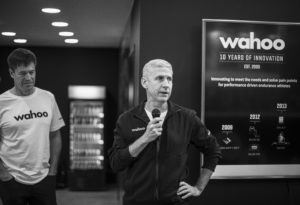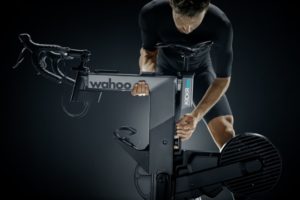After two acquisitions in quick succession, Wahoo’s tenth year has proven to be far more than just an anniversary. Rebecca Morley catches up with CEO Mike Saturnia as he talks acquisitions, turning points and company culture
Wahoo is celebrating a decade in business this year. The company was founded in 2009 by Chip Hawkins, who started getting into cycling and triathlons back in the mid to late 1990s.
As any good cyclist and triathlete would do, Hawkins bought the gear that goes with it and started riding with a group.
“He was incredibly frustrated with the inability to line up the GPS data with the power data and the heart rate data because they all had different data sources,” Mike Saturnia, Wahoo Fitness CEO, tells BikeBiz.

“He built a spreadsheet so he could put all his data within that and then he started doing that for all his racing and cycling buddies, but then he thought: ‘There must be an easier way’.
“He had an iPhone, which was really new at the time, and he realised that it was basically a computer on handlebars, so why wouldn’t we just use this to collect the data? So he built the Wahoo Key – that was Wahoo’s first product.”
Since then, the company has also launched the Tickr, a Bluetooth enabled heart rate monitor, but Saturnia says the thing that really “changed everything” for Wahoo was the launch of the Kickr.
“That took us from being a gadget and tech company to being a cycling company because that product really gained traction and struck a chord with cyclists.
“It was, in many ways, the product that pivoted us to becoming really focused on cycling. In 2016, we launched the Elemnt which was our entry into the bike computer business, which was a new category for us.
“We’ve had a series of product launches and category expansive activities.
“The business has really grown a lot since 2009, and has been continuing to grow rapidly even in the last couple of years.”
But Saturnia says that personally, the Elemnt bike computer was a big turning point in many ways because it took Wahoo from being an indoor training company to being something significantly different, and it showed that there is an alternative in the marketplace.
“The Kickr bike is such an incredible product, so much different to anything else on the market. It required an incredible amount of effort from the whole organisation to really take a simple concept of taking your outdoor bike and replicating it inside, but it really is difficult to do, and I think we did it incredibly well and better than anybody else who’s done it so far.”

But how has the rest of the market reacted to these products? “On the bike computer side, the industry’s response has been great,” Saturnia says.
“Our sales are growing really rapidly and so is our market share. In many ways, I’m surprised at how well the market has responded, knowing that we didn’t have a reputation in that category before.
“The Kickr bike has responded extremely well, the reviews have been strong, the consumer demand has been strong. It’s a really early-stage product, we haven’t even started shipping it yet, but the early signs are really positive.”
Eurobike 2019 saw Wahoo launch the Kickr bike, the “first smart bike that’s built on the world’s leading indoor cycling training ecosystems”. It is the culmination of years of experience developing the entire Kickr ecosystem of integrated training products.
Gaining momentum
The indoor training market is one that has seen growth recently, with a technological revolution gathering momentum within sport. Saturnia says that Wahoo expects this growth to continue, both in terms of the technology but also in terms of participation.
“If you think about how much indoor cycling has grown in the last five years, you think: ‘Wow, how much more growth can there be?’
“If you look at the number of serious cyclists that are in the world, and then you look at the number of serious cyclists who actually cycle indoors, it’s still a relatively low percentage. In fact, it’s a very low percentage.
“There’s a lot of upside still, from our perspective. I do think they’ll be more people coming in because it’s growing so rapidly and there is still such room for continued growth.
“But that’s a good thing, because innovation and new players, hopefully, innovative new players, bring awareness to the category, and drive participation.
“Right now, we’re fortunate to be in a category that has so much growth potential. The more people who innovate and the more things that come in, whether they’re competitive products or not, it’s good for the category and if it’s good for the category then we think it’s going to be good for Wahoo long term.”
Sufferfest and Speedplay
Wahoo has also made two acquisitions recently. In July this year, it announced its intention to acquire endurance training platform The Sufferfest. At the time, the company said it increases the brands’ “combined capability to create training solutions for endurance athletes who want to get the most out of themselves”.
Then a few months later, in September, Wahoo acquired pedal brand Speedplay with the intention of putting its pedals on “as many bicycles as possible and continue to drive creativity at this celebrated brand”.
“Obviously they’re very different companies,” Saturnia explains. “We didn’t start off thinking we wanted to be an acquisition company, in fact it couldn’t be anything further from how we think about things, but there were good reasons for both of them.
“Sufferfest was really driven by our desire to have more control over the consumer experience from an indoor training perspective, obviously a lot of people use our Kickrs, but that’s not the same.
“Half of the experience is software, so we wanted to have some better control and operate in that segment, which really drives engagement. Ultimately Sufferfest is a really good training platform and we see our value proposition in really helping people perform better.
“That makes sense, we participate in the hardware side of indoor training, why not participate in the broader experience and be true to our DNA, and our DNA is driven around performance enhancement. That’s why Sufferfest makes sense.”
Saturnia continues: “Speedplay is different, in fact it’s kind of the opposite. We saw Speedplay as part of how we build out our outdoor ecosystem of product. It’s got great technology but it hasn’t thoroughly invested behind the business that much in recent years, so it fits really nicely into our portfolio of high-performance, innovative leading-edge products.
“We can grow that through our sales channels, our distribution, our marketing and really just simplifying and investing in the business.”
Despite already having made these acquisitions, Saturnia says it’s not necessarily something it will look to do more of in the future.
“We aren’t really an acquisition company, we like to innovate and grow organically, so we’re not really looking to put more stuff out there – I mean if something comes along I guess you can always take a look at it.
“We’re focused on our strategy of building out our ecosystem and focusing on the cyclist and the endurance athlete, and we think a lot of that’s going to come organically.”
Forward-thinking
So what is the company’s vision going forward?
“We want to be a leader in smart training, and we’re focused on cyclists and endurance athletes,” Saturnia says. “We don’t want to be all things to all people, we want to be very focused on that.
“We want to build out an ecosystem of products and connect those through software, and ultimately drive great consumer experiences. We see a lot of growth in cycling, and we see a lot of growth with triathlon, and so we’ll just continue to innovate in those categories.”

But speaking about what makes it successful now as a company, Saturnia says it would be hard to talk about Wahoo without talking about the culture that exists there.
“What makes Wahoo successful and a special place is really the culture and that starts with the people that work here.
“We’re basically a company of cyclists, and that’s one of the reasons why we’re able to launch really cool products because we’ve got a bunch of people who are passionate and really care about what it is that they do.
“We understand the user because we’re all users ourselves. That authenticity is, in our minds, the secret to our success.
“That’s the reason Wahoo is successful. It started with Chip, when he founded the company and it carries through today with the 200 or so employees that we have now.
“They all have a very similar mindset, very entrepreneurial, very much in tune with the industry that we serve, and passionate about delivering innovative, exciting stuff for the users, because we’re kind of doing it for ourselves.”
 BikeBiz Bicycle and cycling retail news
BikeBiz Bicycle and cycling retail news




